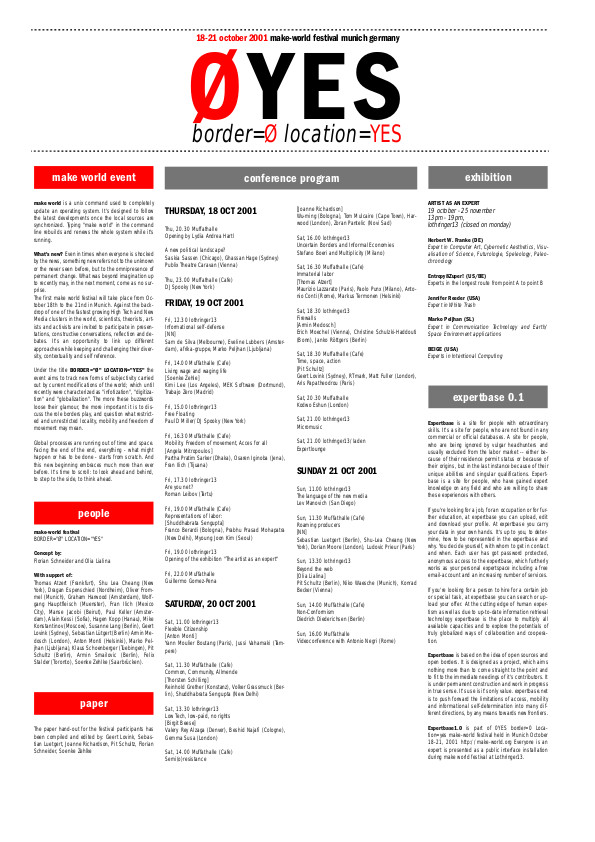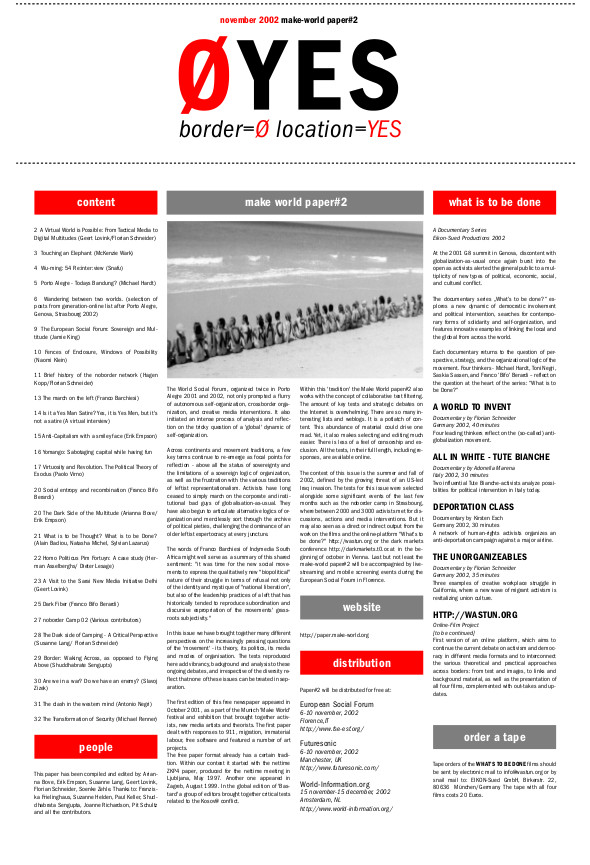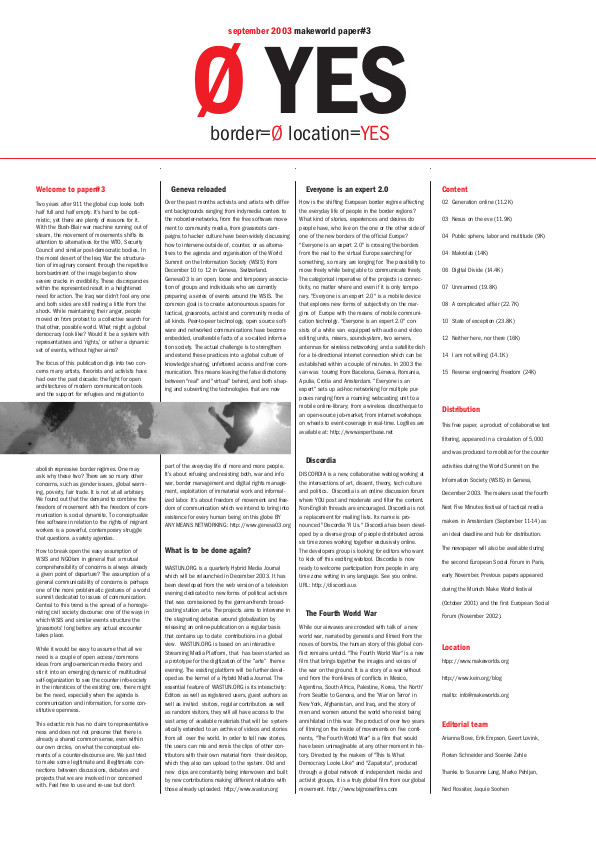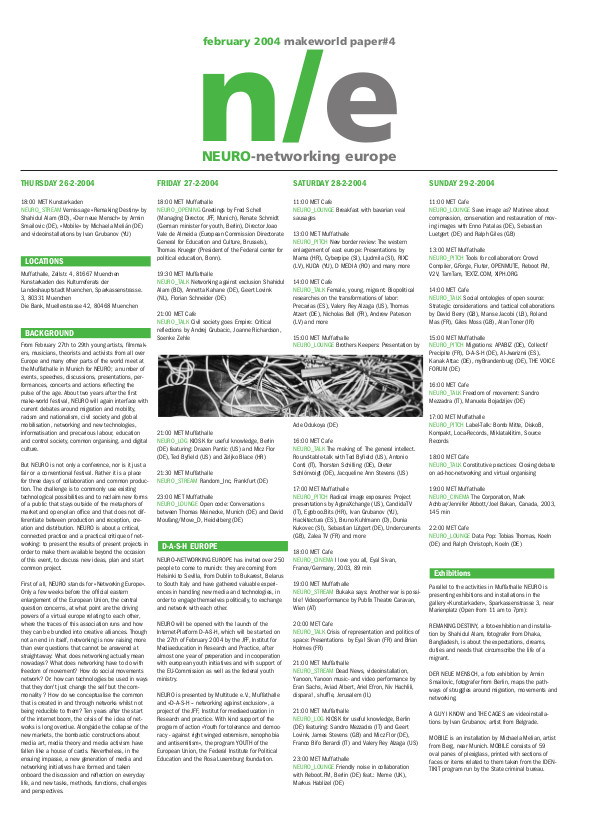Makeworlds papers 1-4 (2001-2004)
Filed under magazine | Tags: · activism, civil society, globalisation, human rights, information society, networks

make world is a unix command used to completely update an operating system. It’s designed to follow the latest developments once the local sources are synchronized. Typing “make world” in the command line rebuilds and renews the whole system while it’s running. The first make-world festival took place from October 18th to the 21nd, 2001 in Munich. Against the backdrop of one of the fastest growing High Tech and New Media clusters in the world, scientists, theorists, artists and activists were invited to participate in presentations, constructive conversations, reflection and debates. It was an opportunity to link up different approaches while keeping and challenging their diversity, contextuality and self reference.
Under the title BORDER=”0″ LOCATION=”YES” the make world paper#1 aimed to track new forms of subjectivity carried out by current modifications of the world; which until recently were characterized as “infotization”, “digitization” and “globalization”. The more these buzzwords loose their glamour, the more important it is to discuss the role borders play, and question what restricted and unrestricted locality, mobility and freedom of movement may mean.
Compiled and edited by Geert Lovink, Sebastian Luetgert, Joanne Richardson, Pit Schultz, Florian Schneider, Soenke Zehlke
32 pages
PDF (updated on 2013-8-10)

One year after the make-world conference, paper#2 has been released at the occasion of the European Social Forum in Florence in the beginning of November 2002.
Compiled and edited by Arianna Bove, Erik Empson, Susanne Lang, Geert Lovink, Florian Schneider, Soenke Zehlke
32 pages
PDF (updated on 2013-8-10)

Make world paper3 has been published on 11 September 2003. It is the third edition of a free newspaper that is distributed in 5,000 copies. Paper3 is geared towards the World Summit on the Information Society in Geneva, in December 2003.
Edited by Arianna Bove, Erik Empson, Geert Lovink, Florian Schneider, Soenke Zehlke
16 pages
PDF (updated on 2013-8-10)

Makeworlds paper#4 is a product of collaborative text filtering and appeared in a circulation of 10,000 hard copies on dead tree. It was produced as a collection of associated or complementary or auxiliary text material at the occasion of NEURO–networking europe, from February 26-29, 2004 in Munich (DE). But also beyond the actual event the paper will be valuable as a entry point to the various debates, presentations, workshops and audio-visual productions during and around the festival.
Edited by Arianna Bove, Annett Busch, Erik Empson, Susanna Lang, Geert Lovink, Sebastian Luetgert, Florian Schneider, Mathias Wrba, Soenke Zehlke
Publisher Multitude, Bernau b. Berlin
32 pages
PDF (updated on 2013-8-10)
Comment (0)Matthew Fuller: Media Ecologies: Materialist Energies in Art and Technoculture (2005)
Filed under book | Tags: · art, cctv, hylomorphism, media ecology, memetics, network culture, new media, philosophy, pirate radio, surveillance, technology

In Media Ecologies, Matthew Fuller asks what happens when media systems interact. Complex objects such as media systems—understood here as processes, or elements in a composition as much as “things”—have become informational as much as physical, but without losing any of their fundamental materiality. Fuller looks at this multiplicitous materiality—how it can be sensed, made use of, and how it makes other possibilities tangible. He investigates the ways the different qualities in media systems can be said to mix and interrelate, and, as he writes, “to produce patterns, dangers, and potentials.”
Fuller draws on texts by Felix Guattari and Gilles Deleuze as well as writings by Friedrich Nietzsche, Marshall McLuhan, Donna Haraway, Friedrich Kittler, and others, to define and extend the idea of “media ecology.” Arguing that the only way to find out about what happens when media systems interact is to carry out such interactions, Fuller traces a series of media ecologies—”taking every path in a labyrinth simultaneously,” as he describes one chapter. He looks at contemporary London-based pirate radio and its interweaving of high- and low-tech media systems; the “medial will to power” illustrated by “the camera that ate itself”; how, as seen in a range of compelling interpretations of new media works, the capacities and behaviors of media objects are affected when they are in “abnormal” relationships with other objects; and each step in a sequence of Web pages, Cctv—world wide watch, that encourages viewers to report crimes seen via webcams.
Contributing to debates around standardization, cultural evolution, cybernetic culture, and surveillance, and inventing a politically challenging aesthetic that links them, Media Ecologies, with its various narrative speeds, scales, frames of references, and voices, does not offer the academically traditional unifying framework; rather, Fuller says, it proposes to capture “an explosion of activity and ideas to which it hopes to add an echo.”
Published by MIT Press, 2005
ISBN 026206247X, 9780262062473
265 pages
PDF (updated on 2012-7-15)
Comment (0)Oliver Grau: Virtual Art: From Illusion To Immersion (2001–)
Filed under book | Tags: · art, illusion, immersion, media history, new media, telepresence, virtual art, virtual reality, virtuality

“Although many people view virtual reality as a new phenomenon, it has its foundations in an unrecognized history of immersive images. Indeed, the search for illusionary visual space can be traced back to antiquity. In this book, Oliver Grau shows how virtual art fits into the art history of illusion and immersion. He describes the metamorphosis of the concepts of art and the image and relates those concepts to interactive art, interface design, agents, telepresence, and image evolution. Grau retells art history as media history, helping us to understand the phenomenon of virtual reality beyond the hype.
Grau shows how each epoch used the technical means available to produce maximum illusion. He discusses frescoes such as those in the Villa dei Misteri in Pompeii and the gardens of the Villa Livia near Primaporta, Renaissance and Baroque illusion spaces, and panoramas, which were the most developed form of illusion achieved through traditional methods of painting and the mass image medium before film. Through a detailed analysis of perhaps the most important German panorama, Anton von Werner’s 1883 The Battle of Sedan, Grau shows how immersion produced emotional responses. He traces immersive cinema through Cinerama, Sensorama, Expanded Cinema, 3-D, Omnimax and IMAX, and the head mounted display with its military origins. He also examines those characteristics of virtual reality that distinguish it from earlier forms of illusionary art. His analysis draws on the work of contemporary artists and groups ART+COM, Maurice Benayoun, Charlotte Davies, Monika Fleischmann, Ken Goldberg, Agnes Hegedues, Eduardo Kac, Knowbotic Research, Laurent Mignonneau, Michael Naimark, Simon Penny, Daniela Plewe, Paul Sermon, Jeffrey Shaw, Karl Sims, Christa Sommerer, and Wolfgang Strauss. Grau offers not just a history of illusionary space but also a theoretical framework for analyzing its phenomenologies, functions, and strategies throughout history and into the future.”
This book is a translation of a revised and expanded version of a book entitled Virtuelle Kunst in Geschichte und Gegenwart: Visuelle Strategien, Berlin: Reimer, 2001.
Translated by Gloria Custance
Publisher MIT Press, 2004
Leonardo Books series
ISBN 0262572230, 9780262572231
430 pages
PDF (updated on 2019-10-13)
Comment (0)
